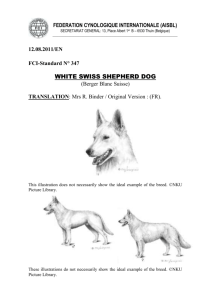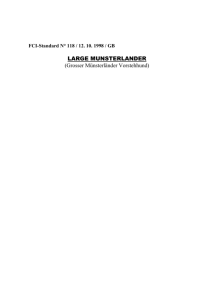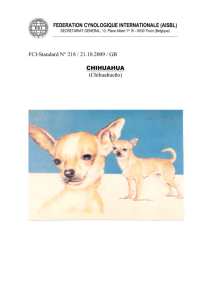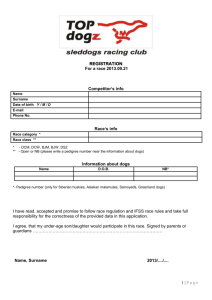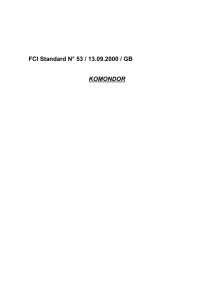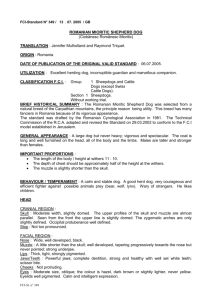FCI-Standard N° 87 / 13. 09. 2004 /GB
advertisement
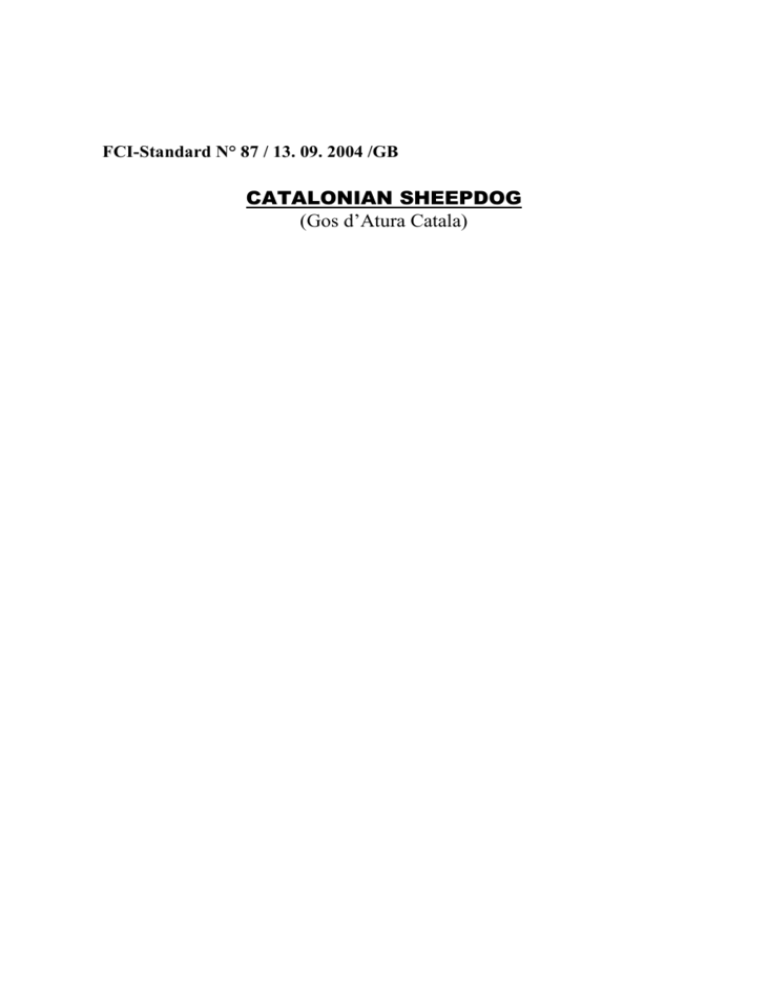
FCI-Standard N° 87 / 13. 09. 2004 /GB CATALONIAN SHEEPDOG (Gos d’Atura Catala) 2 TRANSLATION : Mrs . Peggy Davis. ORIGIN : Spain, Catalonia. DATE OF PUBLICATION OF THE ORIGINAL VALID STANDARD : 26.05.1982. UTILIZATION : It is in the driving of flocks that the true essence of this breed manifests itself, because not only does he obey the shepherd, but in numerous cases, he shows his initiative, directing the flock with marvellous ease, preventing any animal from separating from the others. Through his great bravery and courage, he can also be used for guarding missions. Because of his size, his beautiful coat, his intelligence and his great loyalty to his masters, he can be an excellent companion. CLASSIFICATION F.C.I. : Group 1 Sheepdogs and Cattle Dogs (except Swiss Cattle Dogs). Section 1 Sheepdogs. Without working trial. BRIEF HISTORICAL SUMMARY : Originates from the Catalonian Pyrenees, has propagated in all other pastoral zones of Catalonia. GENERAL APPEARANCE : Of well balanced medium proportion, medium size, with a beautiful coat. IMPORTANT PROPORTIONS : Slightly longer than high, approximately in proportion of 9 to 8. BEHAVIOUR / TEMPERAMENT : A very sedate dog, active and intelligent, with a noble expression, with a hardy and pleasant character, really devoted to the shepherd and flocks entrusted to him, wary of strangers, which at times make him seem unsociable. FCI – St.N°87 3 He is very vigilant, very resistant to heat, cold and all atmospherics. A very frugal alimentation is sufficient for him to work in extreme conditions. HEAD : Strong head, slightly convexe and wide at the base, without heaviness, well proportioned with the rest of the body. The skullmuzzle proportion is of 4 to 3. CRANIAL REGION : Skull : Slightly longer than wide, with a clearly marked furrow in its first third part, which gets flatter and remains so up to the occiput where a crest is formed. Occipital bone pronounced. The upper profile of the skull is slightly domed and may show a less accentuated short space in the middle. The frontal sinus well developed, as much lengthwise as widthwise. Superciliary ridges well marked. Stop : Well visible but not too pronounced. FACIAL REGION : Nose : Straight, proportioned with the head, must be black. Muzzle : Straight, rather short, in shape of a truncated pyramid, with rounded outlines. Lips : Rather strong, short, formed almost straight, with lower lip not pendulous, strongly pigmented with black; the palate is also black. Jaws/Teeth : Strong, of good size, white and sound. Scissor bite. Blunt canines (tusks) are admitted in the working dogs. Eyes : Wide open, expressive, alert and intelligent gaze, round, dark amber colour, with black rimmed eyelids. Ears : Set high, triangular, fine, pointed. Insertion cartilage supple and not thick. Hanging ears, carried close to the head. Ratio between ear width : length = 8 to 10. Covered with long hair ending in mobile fringes. For the working dogs cropped ears are accepted. NECK : Vigorous, solid, muscled, rather short, but with such proportions permitting a good mobility, well tied to the shoulders. FCI – St.N°87 4 BODY : Slightly elongated, strong, muscled, giving an impression of power and agility. Withers : Well visible. Back : Topline straight, not saddle-backed, slightly raised croup, which, in any case, shall be equal or slightly inferior to the withers. That difference at first sight may seem favourable to the croup because of the quantity of coat and undercoat which it carries. Croup : Robust, muscled, slightly sloping. Chest : Wide, well developed, reaching elbow level. Curved ribs, not flat, allowing for a good thoracic capacity in respect of the work. Belly and flanks : Belly slightly tucked up, with short but strong and well marked flanks. TAIL : Rather low set, may be long, going beyond the hock, or short, measuring less than 10 cm. There are also tailless subjects, and, for the working dogs, docked tail is admitted. When the dog is at rest, the tail just hangs. It forms a hook in its lower part. Sabre tail also accepted. In action, the tail is raised gaily but not rolled on the back. Is abundantly covered with slightly wavy hair. LIMBS FOREQUARTERS : Strong, lean, straight, vertical and parallel, seen from the front or in profile. The elbow-wither distance is about equal to that of the elbow to ground. Shoulders : Muscled, strong, slightly oblique. Scapular-humeral angle : Of about 110°. Arm : Strong, muscled with parallel elbows, neither in or out, close to the body. Humeral-radial angle : Of about 135°. Forearm : Vertical, strong, fit for the work. Carpus (Carpal joint) & Metacarpus (Pastern) : Following the same vertical as the forearm, rather short. Feet : Oval, pads black and hard, interdigital membranes neat and well covered with hair, nails black and strong. HINDQUARTERS : Strong, muscled, vertical, giving impression of power and agility. FCI – St.N°87 5 Thighs : Long, broad and muscled, with strong bones. Coxal-femoral angle : Of about 115°. Femoral-tibial angle : Of about 120°. Legs : Strong bones and muscles. Hocks : Must be well let down, parallel and vertical. Angle of hock : About 140°. Metatarsus (Rear pastern) : Rather short, strong and vertical. Feet : Identical to front feet, but with low set double bony dewclaws. These dewclaws are joined together and joined to the first toe of the foot by a membrane. GAIT / MOVEMENT : Supple, typical of shepherd dogs. Gallop only obtained in very large spaces, but in the ring, the typical gait is a short trot, with that gait peculiar to all dogs with dewclaws. SKIN : Rather thick, close and tight all over the body and the head. Well pigmented. COAT : HAIR : Long, flat, or very slightly wavy, rough with abundant undercoat on the whole of the posterior third of the body. On the head we notice a beard, moustaches, tuft and eyebrows which do not affect the sight. Tail well covered with hair as are all the extremities. It is noticeable that during the moult we observe a typical phenomenon : the moult occurs in two times. First of all it affects the coat on the front part, giving the impression of two halves of dogs with different coats; then it is the turn of the hind part of the dog and everything becomes uniform again. COLOUR : Seen from the distance the dog seems to be unicolour and may have lighter shadings at the extremities. Seen close up, it is noticeable that the colour comes from the mixture of hairs of different tones : fawn, brown more or less reddish, grey, black and white. The basic colours deriving from this mixture are : Fawn, in its light tones, medium or dark. FCI – St.N°87 6 Sable, with chestnut hairs, fawn, white and black, also in its light tones, medium and dark. Grey, made up of white, grey and black with shadings going from silver grey to blackgrey. If black is dominant and is simply combined with white, it gives a black which looks frosty. There are also dogs with a mixture of black, fawn and reddish brown, which can dominate in one or several parts, giving the impression of black and tan subjects. Not admitted are white or black spots. Sometimes a few white hairs, as a star shape on the chest are tolerated, or on the upper part of the toes, but, in that case however, this must not be accompanied by white nails. SIZE: Height at withers : From 47 to 55 cm for dogs. From 45 to 53 cm for bitches. FAULTS : Any departure from the foregoing points should be considered a fault and the seriousness with which the fault should be regarded should be in exact proportion to its degree. SERIOUS FAULTS : Head flat or without furrow. Rose shaped ears or badly set. Insertion cartilage thick, long or sticking out. Light eyes. 2 PM missing. Slight prognathism. Saddle back. Legs or feet turned in or out. A few white nails. Lack of bone in the dewclaws or single dewclaw. FCI – St.N°87 7 ELIMINATING FAULTS : Aggressive or overly shy. Lack of pigmentation of the lips, the nose, eyelids and palate. Brown nose. Blue eyes. White spots. Missing more than 2 PM or any two teeth. Tail rolled on the loins. Lack of dewclaws or interdigital membranes. All the nails white. More than 3 cm more or less of the limits of the size. Head like a Pyrenean shepherd or a Briard. Lower or upper prognathism. Quality being equal, we tend to prefer dogs without any mutilations (ears, tail or blunt teeth for reason of work). We shall refuse those with such mutilations if they are not dogs working with flocks. The well pigmented tones are desirable in the colour and therefore better appreciated. Any dog clearly showing physical or behavioural abnormalities shall be disqualified. N.B. : Male animals should have two apparently normal testicles fully descended into the scrotum. FCI – St.N°87
